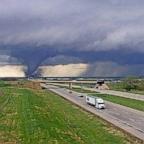Astronomers forgo sleep, eyes fixed on star's explosion
— -- Astronomers are losing sleep and amateur skywatchers are training their sights on an exploding star, or supernova, that is the closest of its kind to be seen in four decades.
Expected to peak in brightness Thursday and Friday, the exploding star is practically next door cosmically speaking, about 21 million light years away, or about 1,240 million-trillion miles. It was first spotted in telescopes Aug. 23.
It is located in the "Pinwheel Galaxy," above the Big Dipper. Telescopes worldwide, including NASA's Swift and Hubble Space Telescopes, turned to observe the celestial fireworks within a day and have been tracking its brightening light ever since.
"I'm running on adrenaline right now. A good night is four hours sleep," says astronomer Peter Nugent of the Energy Department's Lawrence Berkeley (Calif.) National Laboratory, a member of one team tracking the supernova's brightening light for clues to the cause of the star's demise. "The observations are being made the world over," Nugent says.
For amateurs, a 6-inch telescope or a powerful 20x80 (or better) set of binoculars will sharpen the blurry light of the Pinwheel Galaxy and the piercing glint of the exploding star in one of its spiral arms. The best time to see the exploding star, assuming no cloud cover blocks your view, comes just after sunset, before the rising moon washes out the night sky.
"This is an exciting supernova," says Princeton astronomer Michael Strauss, who is not on the observation team. "It is close-by and from a well-studied galaxy that we can see face-on."
The supernova belongs to the widely observed "Type 1a" group, born from runaway thermonuclear combustion in an ancient "white dwarf" star, the burnt-out stub of a normal star that attains a weight 1.38 times heavier than the sun, then blasts itself apart. Type 1a blasts are 10 to 50 times brighter than other supernovas, and the light from the single exploding star is brighter than the light from an entire galaxy.
If such a blast had occurred in our own Milky Way galaxy, the light would probably be visible during the daytime. "In some senses, this is the largest, nearest thermonuclear explosion we can see," Nugent says.
For astronomers, Type 1a stellar explosions are used as standard astronomical yardsticks to gauge how quickly distant galaxies are moving away from each other. These supernova observations led to the discovery that the universe is moving apart at an accelerating rate in 1998, since confirmed by observations of galaxies and other evidence.
"So this type of supernova serves as a 'standard candle' for measuring distances," Strauss says.
Astrophysicists disagree about how white dwarfs, typically about 0.6 the weight of the sun, grow to explosive size. Some may result from two oversized white dwarfs merging with each other, or from one white dwarf robbing gas from a nearby, larger star to add bulk. "You get a little nervous," Strauss says, about using a distant stellar explosion as a cosmological yardstick given the uncertainty.
That's why astronomers are sleeping even less than usual, Nugent says, pursuing every possible view of the explosion for clues to how it unfolded. "I think it is safe to say this will end up being the best-studied Type 1a supernova in history."




